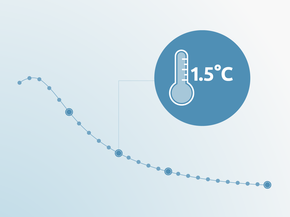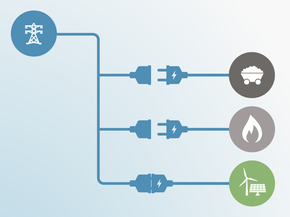Current Policy Projections
Current policies overview
Australia’s current policies fall far short of the emissions reductions required to meet the 2030 target put forward in its NDC. Under current policies in place, Australia’s total GHG emissions excl. LULUCF are projected to rise to about 523–536 MtCO2e by 2020 and 540–583 MtCO2e by 2030. This is equivalent to an increase in emissions from 2005 levels (excl. LULUCF) of 4–7% and 8–16% by 2020 and 2030 respectively (when compared to 1990 levels (excl. LULUCF) this results in an increase of 31–34% and 35–46% respectively). To meet its 2030 emissions targets, Australian emissions should decrease by an average annual rate of between 1.9–2.7 per cent until 2030; instead, with current policies, they are set to increase by an average annual rate of between 0.3–0.7% per year.
Energy
Australia’s primary energy consumption is dominated by fossil fuels; in 2014-15 38% come from oil, followed by 32% coal, 24% gas, followed by a mere 6% of renewable energy (Australian Government, 2016a).
Federal and state energy ministers commissioned a review of the national electricity market, the so-called Finkel review, in 2016. The review highlights “the need for a clear and early decision to implement an Orderly Transition” and recommends that the Australian State and Territory governments agree to an emissions reduction trajectory for the National Electricity Market and the adoption of a Clean Energy Target (Finkel, 2017). The minimum electricity sector emissions reduction pathway suggested in the Finkel Report (26–28% reduction from 2030 levels from 2005) however, is not consistent with other scientific assessments, as its reductions only track the (already insufficient) 2030 reductions proposed for the entire Australian economy (Hare et al., 2017).
Australia’s Renewable Energy Target, introduced in 2010, aims at increasing the share of electricity generation from renewable sources. It consists of two targets: the Small-scale Renewable Energy Scheme, which supports small-scale installations like household solar panels and solar hot water systems, and the Large-scale Renewable Energy Target (LRET). The LRET originally aimed to achieve 41 TWh of additional renewable electricity generation by 2020, but, in 2015, the government reduced this target to 33 TWh. In the same year, coal consumption rose by 3%, due to increased black and brown coal use in electricity generation (Australian Government, 2016).
Coal has featured prominently in in Government statements on energy security and the future of Australia’s power system. However, on the ground, there is little appetite for new coal generation from utilities and industry, nor from the general public. Nine coal power stations have been retired in the last five years, including Hazelwood, a 1,600 MW lignite coal-fired plant. This illustrates the economic challenges coal plants face in Australia against continuously decreasing costs of renewables and storage, rather than “climate-induced political fiddling” as suggested by former Prime minister Tony Abbott (2017). Due to the politically unstable environment on climate policy, investment uncertainty remains high over what kind of power plants to build as ageing coal plants are shut down. Wholesale power prices have doubled since the carbon price scheme and related legislation was axed, fuelling calls for an emissions intensity-based carbon pricing scheme for the electricity sector (Morton, 2017). Even this measure was ruled out by the Turnbull government, although analysis suggests it could save households and businesses up to AUS$15 billion in electricity bills over a decade (Morton, 2016).
The AUS$500 million funding cuts to the Australian Renewable Energy Agency (ARENA) may further impact the development of clean energy in Australia, hampering the rate of development and innovation needed, as well as adding to increased investor uncertainty (Clean Energy Council, 2016).
On the subnational level, climate action is more visible. South Australia has a 50% renewable energy target by 2025, which is now close to being achieved, and aims to achieve net zero emissions by 2050 (Government of South Australia, 2016). Last year a blackout in South Australia, caused by extreme weather conditions, resulted in the loss of three significant transmission lines. This event was used by the Federal Government to mount a national campaign against renewable energy, specifically wind power, in favour of coal, despite the fact that wind farms were found not to have been at fault in the state-wide power failure (Department of State Development, 2016). The debate reached global attention when Tesla CEO Elon Musk placed a bet to solve South Australia’s grid stability problem (BloombergGadfly, 2017) by offering to install a 100 MWh energy-storage plant within 100 days at a battery-pack price of US$250/kWh, aiming to demonstrate the viability of renewable energy and its benefits. A recent study finds that Australia could build an affordable and secure electricity network with 100 percent renewable energy, using existing technologies (Blakers, Lu, & Stocks, 2017). A report by the Commonwealth Scientific and Industrial Research Organisation (CSIRO) and Energy Networks Australia (ENA) finds that a decarbonised energy grid by 2050, with half of generation produced and stored locally, will save billions in upfront capital costs and consumer bills, and deliver a secure electricity system (Australia Energy Networks & CSIRO, 2016).
Australia’s Emissions Reduction Fund (ERF) is a reverse auction mechanism that aims to “reduce emissions at lowest cost over the period to 2020” (Australian Government, 2014, p. 68). However, the ERF—the so-called “centrepiece” of the Australian Government’s policy suite to reduce emissions—does not set Australia on a path towards meeting its NDC target. The ERF’s fifth auction took place in April 2017, with AUS$133 million committed to purchase 11.25 million tonnes of abatement (an average price per tonne of abatement of AUS$11.82 (Australian Government, 2017). Compared to previous auctions, participation was low, reflecting the negative market sentiment in the ERF. The administrative complexity of the fund, as well as the low average auction price, pose barriers of participation, in particular for high emitting companies (Reputex, 2017). In addition, the fund is plagued by a mismatch of its abatement profile (concentrated in the land sector) with Australia’s emissions profile which is driven by industrial and power sectors, and concerns about additionality, as it is difficult to know whether the emissions reductions would have occurred anyway. The ERF is also the subject of fiscal concern due to its cost to the taxpayer.
Alongside the reverse auction, the ERF includes a safeguard mechanism, which began operations in July 2016, with a goal of limiting significant emissions increases from large industrial sources to a baseline emission level. This mechanism applies to around 140 businesses that have facilities with direct emissions of more than 100 ktCO2e. For these facilities, the government set a baseline level using the highest level of reported emissions for a facility over the historical period 2009/2010 to 2013/2014. (Australian Government, 2016b). An analysis has shown that as a result of this generous baseline, the mechanism is not expected to reduce emissions (RepuTex, 2015). At the same time, the same analysts predict that declining emissions baselines will eventually have to be implemented, stating the safeguard mechanism to be the only remaining policy able to deliver large emissions reductions (RepuTex, 2017).
The National Energy Productivity Plan 2015–2030 aims to improve energy productivity by 40% by 2030 through “encouraging more productive consumer choices and promoting more productive energy services” (Australian Government, 2015b). It defines energy productivity as how much value is generated from investment in energy (economic output/energy used) and sets out a workplan that contains broad policy measures as the first steps in the 15 year life of the Plan. More productive consumer choices will be encouraged through efficient incentives, empowering consumers and helping business compete. More productive energy services will be promoted through innovation support, competitive modern markets and consumer protections.
Further analysis
Latest publications
Stay informed
Subscribe to our newsletter






